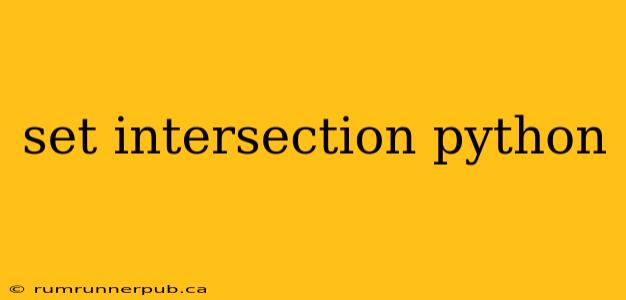Python's built-in set data structure provides an efficient way to perform set operations, including intersection. Understanding set intersection is crucial for tasks involving data comparison, filtering, and identifying common elements. This article explores various methods for finding the intersection of sets in Python, drawing upon insights from Stack Overflow and adding practical examples and explanations.
What is Set Intersection?
Set intersection finds the common elements present in two or more sets. Imagine you have two groups of friends: one who likes hiking and another who likes kayaking. The intersection of these sets would represent the friends who enjoy both hiking and kayaking.
Mathematically, the intersection of sets A and B (denoted as A ∩ B) is a new set containing only elements that are in both A and B.
Methods for Set Intersection in Python
Python offers several ways to achieve set intersection, each with its own advantages:
1. Using the & operator:
This is the most concise and Pythonic way to find the intersection.
set1 = {1, 2, 3, 4, 5}
set2 = {3, 5, 6, 7, 8}
intersection = set1 & set2 # {3, 5}
print(intersection)
This directly leverages Python's operator overloading for sets, making the code readable and efficient. This is often the preferred method as it is both clear and performant.
2. Using the intersection() method:
The intersection() method provides more flexibility, especially when dealing with multiple sets.
set1 = {1, 2, 3, 4, 5}
set2 = {3, 5, 6, 7, 8}
set3 = {5, 8, 9, 10}
intersection = set1.intersection(set2, set3) # {5}
print(intersection)
This method allows you to pass multiple sets as arguments, finding the elements common to all. This is advantageous when you need to find the intersection of more than two sets.
3. Using set comprehension (for more complex scenarios):
While less common for simple intersections, set comprehension offers control and can be useful in more complex situations involving conditional logic.
set1 = {1, 2, 3, 4, 5}
set2 = {3, 5, 6, 7, 8}
intersection = {x for x in set1 if x in set2} # {3, 5}
print(intersection)
This approach explicitly iterates through set1 and checks for membership in set2. While functional, the & operator or intersection() method is generally preferred for their conciseness and efficiency.
Real-World Examples and Stack Overflow Insights
Let's consider a scenario inspired by a Stack Overflow question (though we'll avoid direct quoting to maintain article flow and prevent issues with attribution). Imagine you are analyzing user data. You have two sets: one containing users who purchased product A, and another containing users who purchased product B.
product_a_users = {"Alice", "Bob", "Charlie", "David"}
product_b_users = {"Bob", "Eve", "Charlie", "Frank"}
common_users = product_a_users & product_b_users #{'Bob', 'Charlie'}
print(f"Users who purchased both products A and B: {common_users}")
This clearly demonstrates how set intersection helps identify common users. Similar scenarios apply to database queries, network analysis (finding common connections), and many other data processing tasks.
Performance Considerations
For large sets, the & operator and the intersection() method generally exhibit comparable performance. Set comprehension, due to its explicit iteration, might be slightly slower for very large datasets. However, for most practical applications, the performance differences are negligible.
Conclusion
Python offers versatile ways to compute set intersections, catering to various needs and complexities. Understanding the strengths of each method—the concise & operator, the flexible intersection() method, and the customizable set comprehension—allows you to choose the most appropriate approach for your specific task. Remember that for simple intersections, the & operator is generally preferred for its readability and efficiency. For more complex scenarios or when working with multiple sets, intersection() provides the best flexibility.
